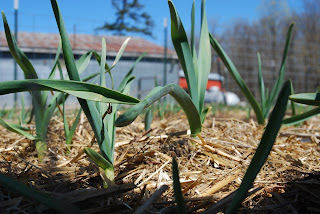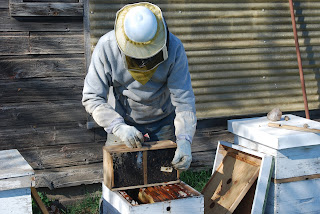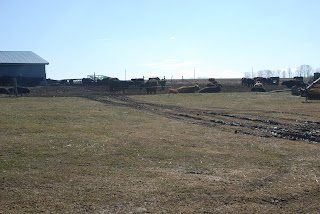
While Craig and Willa were away from the farm for the afternoon last Sunday Olivia, Gabe, and I took a walk in the woods to see what's up. Having picked ramps for a number of years now, hearing the chef from L'Etoile in Madison earlier in the week on WPR raving about the ramps now available in southwest WI prompted a check to see if we might be able to harvest some of these wild leeks (or wild garlic as they are also called). They are up and growing but the edible bulbs are pretty puny yet. We just let them be for now.
We were delighted to find an abundance of spring flowers in bloom. Above is spring beauty, also known as "fairy spuds" because of their starchy, edible roots. (As an aside on this: if you are interested in a guide to identifying, harvesting, and preparing edible wild plants we would like to suggest Samuel Thayer's The Forager's Harvest. Sam lives in Wisconsin and offers foraging workshops.) The eight petaled white flower is bloodroot, so named for the red orange juice in the stems and roots used by many cultures as a dye and insect repellent. Below is the yellow trout lily. "Trout" because of the mottled leaves resembling the coloring of the brown trout. Missing is the photo of the common dandelion. Those who chronicle such things have remarked that the dandelions made an uncommonly early appearance this year: in the southern parts of the state some 7 weeks earlier than is usual. While not quite that precocious here in central Wisconsin, wild flowers and birds are ahead of schedule here as well.

And...up in our garden and seen below: the garlic. Our garlic beds took a beating when a couple cows decided to break through the garden fence and take a stroll through the garden. Aggravating, but not irreparable.

Other new faces at Ninepatch this week: Broiler chicks who will spend the first couple weeks of their lives under the warmth of the brooder. These birds are the first in a succession of 9 batches that will arrive every two weeks over the spring and early summer and will be incredibly fresh when seen at the farmer's market on June 12th.
So where were Craig and Willa? At Lapp's in Reeseville, WI. They returned home late in the afternoon on this sunny Sunday with bees. While we had been successful in overwintering a large percent of our bees, we needed to supplement our colonies. Here you see Craig installing bees into one of 14 hives he keeps. The next day a check revealed bees with pollen on their legs in the hives. They had gone right to work!
Included in the week's activities here in the town of Hamburg was a visit from our son, Dylan and his wife, Joanna. Always ready to go to work, they put their energy into Joanna's idea of ferreting out some of the scrap metal laying about the farm, loading it onto the pick-up truck and trailer and seeing if, in the process of beautifying the farm, they might also make a profit. They did both!























